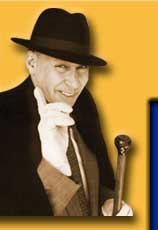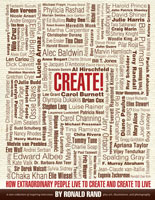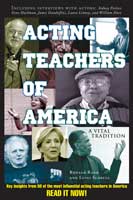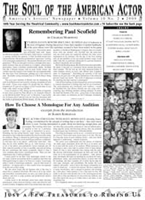|
For
Teachers
Harold Clurman and The Group Theatre:
A Celebration and a Call to Action
| Part I & II | Part
III | Part IV | Part
V | Additional Materials | Student & Teacher
Feedback |
Educational Guide - Part III
III. EXAMINING THE HOW
A. How was The Group Theatre assembled?
1. What were the first steps taken to launch the company’s work?
Clurman and Crawford approached the board of The Theatre Guild and presented
a paper, proposing the theatre subsidize their early efforts. The Guild responded
by giving them permission to rehearse Paul Green’s The House of Connelly
(to which they owned the rights) and by offering a $1000 gift to help finance
rehearsals outside the city at a summer retreat.
2. How did the Group select its members?
Clurman, Strasberg, and Crawford interviewed nearly 50 actors and eventually
selected 28 for membership in the still unnamed Group Theatre. The three
leaders were most interested in finding actors whom they felt would commit
to their ideals and had a serious desire to develop their craft; talent,
though important, was a secondary consideration. Those chosen were drawn
from The Theatre Guild, the Steinway Hall gatherings, and the acquaintances
of The Group leaders. They included Phoebe Brand, Joe Bromberg, Morris Carnovsky,
Sanford Meisner, Clifford Odets, Franchot Tone and Stella Adler (whom Clurman
had since fallen in love with and persuaded to join them, though Adler was
already an experienced actress of some reputation).
In June of 1931, the 28 invited actors and the three Group Theatre
leaders prepared to retreat to Brookfield Center in Connecticut, where
they would rehearse
Paul Green’s play, with Strasberg directing and Crawford appointed as
co-director.
Soon, the theatre that the three leaders had been calling “our group” since
its conception gained a fitting name, The Group Theatre.
B. What was the Group Idea?
1. Development of a common technique and vocabulary
All The Group Theatre actors were to be trained in the Stanislavsky system.
As Clurman explains, “The system was not an end in itself, but a means
employed for the true interpretation of plays” (Fervent Years, 43).
This system was “a way of organizing the study of parts” designed
to “enable the actor to use himself more consciously as an instrument
for the attainment of truth” (Fervent Years, 43). This technique allowed
the directors to more efficiently communicate with their actors in order
to help them produce the desired results; furthermore, it led to productions
unified by a single, consistent acting style.
2. The belief that the artist’s learning is never finished and
that artists profit from continued study and continuous practice of their
craft.
3. The use of a permanent ensemble of actors
Actors would be part of an ensemble and would play parts of all sizes.
They would not be guaranteed a role in each play, but would be paid
for
each nonetheless.
The size of the actors’ roles did not determine their salary, rather
variations in pay tended to reflect actor’s individual needs (in other
words, those supporting a family might be paid a higher wage). The fact that
all the Group plays had to be cast out of the limited pool of the Group members
meant that the type casting typical of the commercial theatre was not a feature
of The Group’s casting policies. The Group actors were often stretched
by challenging roles and were able to develop impressive range by working on
a variety of parts that would have never been offered them in the commercial
realm.
4. The presentation of plays offering a hopeful, affirmative vision of American
society, while grappling with real life, contemporary issues
The Group Theatre was committed to choosing plays that offered a meaningful
comment on society and conveyed a “yea-saying rather than a nay-saying” view
of humanity and the future (Collected Works, 1050). “Every good play
is propaganda for a better life,” Clurman is said to have declared (Reunion,
481).
5. Well-written, high quality new plays by American playwrights
6. The belief that artists must have a sense of social responsibility
and that their concerns as artists must extend beyond the limits of their
individual disciplines. Clurman longed to widen the moral and artistic
scope of the actor.
7. The theatre should offer its audience more than just entertainment,
but rather a communion, an experience that is alive and involves emotional
and energetic exchange between actors and audience.
8. The pursuit of a shared social and artistic purpose, deeply felt
by the actors, linking them to the impulse of the playwright (whose work
was selected as an embodiment of the company’s philosophy).
**Question: What Ideas drive our contemporary theatre?
C. What were the goals and major components of The Group’s process?
1. The cultivation of young American playwrights who might develop from
within their ranks and be able to effectively and dramatically articulate
their shared ideas.
2. The use of long rehearsal periods, allowing actors to work organically
to explore their roles, rather than just deliver immediate results.
3. Exposing actors to classes to elevate skill, discipline and technique
and to facilitate their continuous artistic growth
The Group actors trained together in classes focusing on speech and voice,
movement, improvisation, playwriting, dance and more.
4. Rehearsals incorporating improvisation and exercises
Improvisations, used as a rehearsal tool, required the actors to engage in
scenes that might occur in the world of the play, but did not exist in the
play’s text. They would use their own words in these unplanned scenes,
forcing them to respond spontaneously out of a personal understanding of
their character’s experience. These improvisations also helped to develop
rich and believable relationships between characters and a strong ensemble
sense of the detailed world of the play.
5. An emphasis on attaining emotional truth onstage as the core of the
actor’s work
Strasberg trained The Group actors in the use of Affective Memory (also known
as Emotional Memory), designed to help actors to freely express authentic emotion
at key emotional moments on stage. These exercises asked the actor to delve
into his own personal life, searching for an incident in which he had experienced
emotions parallel to those expressed by his character. He would use his memory
of this event to allow him to emotionally connect to the character’s
situation.
6. Clurman’s motivational talks
Clurman spoke to the actors regularly and at length about a variety of topics
related to theatre history, influential movements and figures in other artistic
disciplines, and the social and moral dilemmas of their times. He gave the
ensemble a sense that their participation in The Group Theatre had great
significance and that their present actions were linked to an entire history
and tradition;
in so doing, he invested
them with a strong sense of artistic and historical purpose.
**Question: Do we, as artists, have a sense of personal connection to
this history and tradition today?
7. Performance in repertory
This practice of running more than one show at a time and reviving shows previously
produced proved to be very beneficial for The Group Theatre. It allowed them
to maximize the involvement of the large ensemble, to give more than one
Group actor the opportunity to play a given role, and to tour shows with
part of the company while others rehearsed or performed in Group work back
in New York. This practice was central to the Group Idea because, as Clurman
observed, “For a theatre to grow, continuity of activity is indispensable.” Additionally,
it was important, Clurman believed, to offer audiences more than one chance
to experience a play, particularly when timing, and the hasty, short-sighted
assessments of critics can so dramatically color the reception of a worthy
piece.
D. What problems did The Group Theatre face and how did they respond?
1. Lack of money
The Group funded productions on a show-by-show basis, and was therefore always
facing the threat of extinction. If no money was provided to fund the next
project, there could be no next project. Regardless of this reality, The
Group began rehearsals again and again for projects that did not receive
backing until shortly before opening. Crawford was chiefly responsible for
acquiring funding and her efforts allowed the organization to produce years
of work on Broadway, though many shows closed prematurely and their future
was, at each moment, somewhat uncertain.
The Group Theatre also struggled to sustain its membership, who, despite
the low and unreliable salaries, remained very loyal to The Group, often
volunteering
to take pay cuts to prevent a show from closing.
2. Lack of plays
Over the years, Clurman continually lamented the shortage of well-written plays
that dealt realistically and frankly with the American experience. Often
it was a toss-up between which obstacle would dominate, the lack of money
to produce a play or the lack of material to produce. Both brought their
progress to a temporary halt from time to time, though with the emergence
of Odets, the Group found the “home-grown” playwright it had
been longing for and was able to encourage and participate in his creative
growth.
3. Producing as a non-commercial theatre on Broadway
The Group Theatre was an art theatre with non-commercial aims producing within
a highly competitive commercial framework. In other words, it could not attain
success in conventional terms because it didn’t employ the necessary
methods; play selection and casting, for instance, were not driven by financial
interests, rather by artistic concerns. In The Group Theatre’s decision
to produce on Broadway, they found their central dilemma; to be “on
Broadway but not of it” was a complicated task.
4. Lure of Hollywood
Over the years, numerous members of The Group were courted by high profile
Hollywood studios and offered luxury, success, and glamour in a world far
removed from the struggling Group in New York. The great majority refused
these opportunities or did not seek them. They were committed to The Group
and to the theatre and to the artistic and social purpose that united them.
During the years of The Group’s life and especially after its dissolution,
many did work in Hollywood, including Elia Kazan and John Garfield (who joined
The Group as interns in 1932), Clifford Odets, Stella Adler, Morris Carnovsky,
and Clurman himself. Franchot Tone, an original Group company member, left
for Hollywood after only a short time with The Group Theatre. Throughout
the 30’s, however, his feelings of loyalty remained strong, as did
his admiration for Strasberg and Clurman. Tone eventually helped to financially
support several Group productions and often expressed a nostalgic longing
for his days working with The Group. Before the company’s end in 1940,
he returned to perform in another Group production.
5. Schisms within the ranks
a. Diverging notions of technique
i. Stella meets Stanislavsky
In 1934, Clurman and Stella Adler traveled to Europe, and while visiting Paris,
they learned that Stanislavsky was there recovering from ill-health. Clurman
and Adler were able to meet with him, ask him questions, and discuss the
work and technique of The Group Theatre.
Over time, Adler had grown frustrated with Strasberg’s teachings
and the Affective Memory work; she confessed to Stanislavksy that his
system had
destroyed her love of performance. Stanislavsky responded by telling her
that if the system did not work for her, she simply should not use it.
Or perhaps,
he suggested, she was not using it correctly. Adler, at the time, was preparing
for her role in The Group Theatre’s upcoming production of Gentlewoman
by Irwin Shaw. Stanislavsky invited her to work with him on the part. For
the next five weeks, they met for hours a day, while Adler’s assistant
took extensive notes. With this, Stella Adler became the only American actor
to
work on the craft of acting one-on-one with Stanislavsky.
When Adler returned to New York, armed with a new understanding of
the Stanislavsky system, she was eager to set The Group Theatre to a
different course. The Group
was preparing to retreat to Ellenville, the site for the summer’s work,
where rehearsals would commence and where Adler would present classes on
what she had learned from Stanislavsky.
Upon their arrival at Ellenville, Adler gathered the company for an
initial discussion of her findings; Strasberg did not attend.
ii. Adler vs. Strasberg
Adler informed The Group actors that Stanislavsky’s system had undergone
changes in recent years, in response to continued discoveries he had made in
working with his actors. He had all but abandoned the use of Affective Memory,
replacing it with an emphasis on actions and the given circumstances of the
play. To achieve truth and consistency on stage, it was doing, not feeling,
that the actor should focus on, Adler said.
Fascinated with Adler’s new discoveries, the actors found themselves
having to choose between Strasberg’s version of Stanislavsky’s
system and Adler’s. Strasberg, who had until this time been the sole
authority on the system, felt angry and betrayed, declaring that Stanislavsky
had gone back on himself. He insisted that The Group had evidence that affective
memory produced impressive results, and he was not willing to abandon the tool
that he credited with The Group actors’ success. Adler, however, illuminated
the failings of the system as taught by Strasberg, which had already become
a concern for many of The Group’s actors. Additionally, she explained,
Stanislavsky’s new system was the more matured product, the result of
prolonged work and extensive experience. These adjustments to his earlier technique
represented necessary changes in response to important discoveries and observations
made over time.
Adler and Strasberg took this artistic dispute very personally; it
was not simply a matter of professional disagreement, but the source
of much tension
between them, and even personal animosity, which continued for the next 60
years until their deaths.
iii. Complaints from The Group Theatre actors about Strasberg’s
technique
Adler was not the only one of The Group Theatre’s actors who had grown
frustrated with Strasberg’s approach, and particularly with the extensive
use of Affective Memory. Others, including Morris Carnovsky and Sanford Meisner,
had begun to view the tool as destructive and undependable. It was designed
so that, about a minute before an emotionally demanding stage moment, the actor
would begin to recall the personal memory he had selected in rehearsal and
use that memory to help elicit the emotion called for by the script. However,
some Group members had observed that, during the minute in which an actor was
focusing on his memory, he tended to drop in and out of the scene. Because
he was focused internally during this period, he was only minimally invested
in his character’s experience and became temporarily disconnected him
from his scene partner. Some of the younger actors particularly struggled with
Affective Memory. They lacked experience, and thus initially relied heavily
on the tool as the central feature of their technique; in contrast, the older
actors generally viewed the tool as a supplement, but not a foundation.
Years later, Phoebe Brand, one of the youngest original members of
The Group Theatre, explained: “Yes, it was unhealthy…You were digging into
your subconscious life and not with a trained psychiatrist. You could really
do yourself harm in that way, and I think the work disturbed several people” (Reunion,
517).
E. The Group Theatre faces dissolution
1. Events and factors leading to The Group Theatre’s demise
a. Missed financial opportunities and various administrative blunders
led to frustration in The Group actors and tension among its leaders.
In response, Clurman proposed changes in The Group’s organizational
structure. He would serve as managing director and The Group would elect
a committee of actors who would take a more active leadership role in
the company. However, as Clurman realized later, these changes did nothing
to address the fundamental economic instability that was the real root
of The Group Theatre’s problems.
b. As the actors also realized the shortcomings of Clurman’s plan,
they grew increasingly dissatisfied with the faults of The Group leadership
and demanded more say in organizational matters. Several of the actors
formed The Actors Committee and presented a paper to the directors, detailing
their complaints and individually criticizing the three Group leaders
for their personal failings. In a meeting with Crawford and Strasberg,
Clurman suggested they, as the body of directors, collectively resign
and collaborate with the actors on how to move forward. They agreed.
c. The actors proposed the creation of a committee including the directors
and a new group of elected actor representatives. Clurman announced he
would be leaving New York to spend 6 months in Hollywood before The Group
reconvened to launch the next season. A few organizational meetings of
the newly elected body of leaders occurred. Shortly after Clurman’s
departure, Crawford resigned; Strasberg soon followed suit.
d. Clurman returned to New York in the fall of 1937 as the sole director
of The Group Theatre. He set up a small council of actors to advise him;
it consisted of Roman Bohnen, Luther Adler and Elia Kazan. They became
instrumental in the company’s preparations for its next show, Golden
Boy by Odets. To forward the financial stability of the company, Clurman
came to the heartbreaking conclusion that it was necessary to limit The
Group’s official membership to only those actors who were cast
in the upcoming production; The Group Theatre, he felt, could no longer
support those who were not currently involved in production. This represented
a major change in policy, straying from the Group Idea to cut off a number
of actors who had devoted 6 years of life and work to The Group Theatre.
e. Golden Boy turned out to be The Group’s greatest financial
success. Clurman, who directed the play, observed that The Group Theatre
had now become fashionable, attracting a more mainstream and upscale
Broadway
audience.
Thanks to the success of Golden Boy, The Group Theatre was able to form
The Group Theatre Studio, headed by Bobby Lewis, who began to train young
actors and apprentices of The Group. The Group also held New Play Contests,
awarding $100 to a young playwright named Tennessee Williams, which greatly
encouraged him to pursue a career writing for the theatre.
The three Group Theatre seasons that followed, however, did not have
the same impact. Despite fine casts, the directorial debuts of Group
members Kazan and
Lewis, and the introduction of playwrights Robert Ardrey and Irwin Shaw,
The Group was unable to maintain financial stability and continued to
be forced
to seek funding project by project.
At The Group Theatre’s last summer retreat, they began to work on Chekhov’s
Three Sisters. This was planned as The Group’s long overdue attempt to
work on a classic play. However, after many weeks of serious rehearsals, the
project was abandoned, due to lack of funding, personal feuds within The Group,
and the approaching World War. Shaw’s Retreat to Pleasure, in 1940, was
the final Group production.
f. Clurman’s analysis: why The Group Theatre could not escape
demise
i. Eventually, Clurman later reflected, talk was not enough to sustain
actors’ spirits. Inspiration, as a spring board for action, was
ultimately impractical, since in providing it, Clurman was not providing
the fundamental support necessary for Group survival. The situation was,
in the end, emotionally difficult and unhealthy. The Group members, working
for years under strict discipline and an ever-present sense of uncertainty,
were never given the opportunity to experience a release of tension.
The situation never became stable enough that they could relax, knowing
that their hard work had paid off and had provided them with a satisfying
level of comfort and success. Instead, the continued pressure wore on
the souls of Clurman and the actors, until Clurman came to feel he was
unfairly restricting them from other, potentially more lucrative, work.
He could not ask this of them any longer.
ii. According to Clurman, the primary factor responsible for The Group
Theatre’s
demise was the lack of sustained societal or institutional support. Without
the support committed ticket-buying audience or consistent funding provided
by government, civic or private investors, The Group could not survive.
**Question: What kind of funding is available to theatres today? Does
the present economic climate confront today’s theatres with challenges
similar to those faced by The Group Theatre?
| To Part IV |
| Part I & II | Part
III | Part IV | Part
V | Additional Materials | Student & Teacher
Feedback |
|











